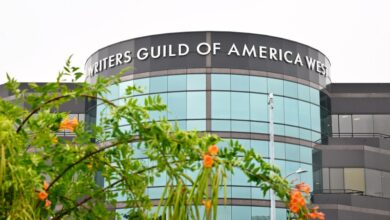17 Short-Sleeve Tops to Wear Instead of Tanks This Summer

Are you tired of wearing the same old tanks and T-shirts every summer? It’s time to elevate your casual wardrobe with some stylish short-sleeve tops that are both comfortable and chic. From polished button-downs to satin shirts, there are plenty of options to choose from that will make you stand out in a crowd.
One of our favorite picks is a polished button-down shirt that comes in nearly 30 colors. It’s so comfortable that no one will know just how stylish you look. Another standout is a lacy short-sleeve top with interesting sleeve details and vertical lines that add a touch of elegance to your outfit.
If you’re looking for something a bit more dressy, consider a satin shirt with a boxy silhouette that can be paired with jeans or a skirt. Or opt for a ruffle peplum top with elbow-length sleeves and front button details for a feminine flair.
For a more boho vibe, try a chiffon-like shirt with ruffle sleeves in over 20 colors. Or go for a ribbed top that can be tucked into shorts for a polished look. The options are endless, from casual shirts with ruffle details to collared tops that transition seamlessly from the office to happy hour.
Whether you prefer a simple V-neck shirt or a textured top with a mock neck, there’s a short-sleeve top for every style and occasion. And with so many colors and styles to choose from, you can easily stock up on your favorites to create a versatile summer wardrobe.
So why settle for boring tanks when you can elevate your look with these stylish short-sleeve tops? Check out our top picks and say goodbye to the summer wardrobe rut. the perspective of a historian focusing on the impact of the Industrial Revolution on society.
The Industrial Revolution was a pivotal period in human history that transformed societies across the globe. Beginning in the late 18th century in Britain, the Industrial Revolution marked a shift from agrarian economies to industrialized ones, leading to significant changes in social, economic, and political structures.
One of the most notable impacts of the Industrial Revolution was the rapid urbanization of populations. As factories and industries sprung up in urban centers, people flocked to cities in search of employment opportunities. This mass migration from rural areas to cities led to overcrowding, poor living conditions, and a strain on infrastructure. Slums and tenements became commonplace, and sanitation and public health issues arose as a result.
The Industrial Revolution also had a profound effect on social classes. The emergence of a capitalist economy based on industrial production created a divide between the wealthy industrialists and the working class. The working class, comprised of factory workers, miners, and laborers, toiled long hours in dangerous conditions for minimal pay. This disparity in wealth and power led to social unrest and the rise of labor movements advocating for workers’ rights and better working conditions.
In addition, the Industrial Revolution brought about significant technological advancements that revolutionized the way people lived and worked. Innovations such as the steam engine, mechanized looms, and the telegraph transformed industries and increased productivity. The development of new transportation systems, such as railways and steamships, revolutionized trade and commerce, connecting distant regions and facilitating the exchange of goods and ideas.
The impact of the Industrial Revolution on society was not limited to economic and technological changes. It also had far-reaching consequences on culture and the environment. The rise of mass production and consumerism led to the commodification of goods and the creation of a consumer culture. This shift in values and attitudes towards material possessions had a lasting impact on societal norms and values.
Furthermore, the Industrial Revolution had detrimental effects on the environment. The rapid expansion of industries led to pollution of air, water, and land, resulting in environmental degradation and health hazards. Deforestation, water contamination, and air pollution were all consequences of unchecked industrial growth.
In conclusion, the Industrial Revolution had a profound and lasting impact on society, transforming economies, social structures, and cultural norms. While it brought about significant advancements in technology and increased productivity, it also led to social inequalities, environmental degradation, and challenges that continue to be felt today. As we reflect on the legacy of the Industrial Revolution, it is important to consider the lessons learned and strive for a more sustainable and equitable future.





